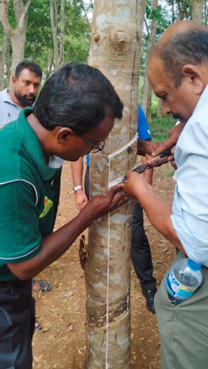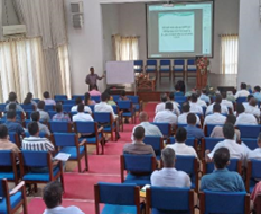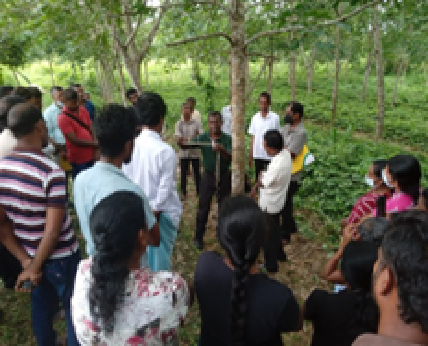Unsustainable taping practices in harvesting Rubber latex leading to aggravated tapping panel dryness and reduction in the economic lifespan of Rubber trees is a predicament in Rubber plantation sector of Sri Lanka, directly affecting quantity and quality of the yield.
 In order to obtain the potential yield, each panel (120 cm of height) should be exploited for at least 6 years i.e. under half spiral cut every other day generally termed as S/2d2 tapping. But at present, a panel is consumed within 3-4 years for high yields in commercial scale. Prevailing higher prices for raw rubber could be a one reason for that. In a situation like this, the crop loss in long term is heavy and also the percentage tapping panel dryness (TPD) is very high in rubber plantations. This situation leads to poor bark management in rubber plantations resulting in either uprooting before full economic lifespan or maintaining at uneconomical levels. The higher rates of bark consumption result in shifting to other panels early and therefore harvesting being continued on comparatively smaller trees and on partially renewed bark. Hence, proper knowledge of tappers for correct bark management should be advised. Also, basic knowledge on anatomical and physiological changes are very important to identify the causes for low yield and for the stresses built up in trees with this situation.
In order to obtain the potential yield, each panel (120 cm of height) should be exploited for at least 6 years i.e. under half spiral cut every other day generally termed as S/2d2 tapping. But at present, a panel is consumed within 3-4 years for high yields in commercial scale. Prevailing higher prices for raw rubber could be a one reason for that. In a situation like this, the crop loss in long term is heavy and also the percentage tapping panel dryness (TPD) is very high in rubber plantations. This situation leads to poor bark management in rubber plantations resulting in either uprooting before full economic lifespan or maintaining at uneconomical levels. The higher rates of bark consumption result in shifting to other panels early and therefore harvesting being continued on comparatively smaller trees and on partially renewed bark. Hence, proper knowledge of tappers for correct bark management should be advised. Also, basic knowledge on anatomical and physiological changes are very important to identify the causes for low yield and for the stresses built up in trees with this situation.
On the other hand, as per the Central Bank records, Rubber products have contributed to the highest export income as a single category by October 2022 adding an income of USD 57.5 million to the national economy. Therefore, it is a crucial need to enhance the sustainability and productivity of Rubber latex yields to gain economic benefits.
To address this vital need, Dr T.U.K. Silva, Senior Research Officer and Head, Plant Science Department, Rubber Research Institute of Sri Lanka took the leadership to introduce a new technique for sustainable tapping of Rubber latex through efficient bark management in Rubber growing areas of the country.
This is based on a past overseas training received by Dr Silva for a Special Training on Latex Harvesting Physiology and Bark Anatomical Studies at the Rubber Research Institute of China, Chinese Academy of Tropical Agricultural Sciences (CATAS), Haikou, Hainan under the Overseas Special Training Programme (OSTP) and a research grant of the NSF.
Harvesting Physiology and Bark Anatomical Studies at the Rubber Research Institute of China, Chinese Academy of Tropical Agricultural Sciences (CATAS), Haikou, Hainan under the Overseas Special Training Programme (OSTP) and a research grant of the NSF.
This project was aimed at creating awareness and building capacities of the field staff of small holders and large scale Rubber plantations on sustainable bark consumption of Rubber through know-how and technology transfer, so that an optimal yield over the full productive lifespan could be obtained, leading to enhance economic gains.
The project was conducted from mid-2022 to early-2023. At the end of the project period, around 1000 field staff including Field Officers from the Rubber Development Department (RDD) and the private sector plantations, Estate Superintendents, Estate Managers, Rubber Tappers, etc. from four rubber-growing districts namely Kalutara, Ratnapura, Kegalle and Moneragala were trained. They were mainly from the small holder sector and Regional Plantation Companies (RPCs).
 According to the estimates by the RRISL’s project team a considerable productivity enhancement leading to elevated socioeconomic benefits could be envisaged in the long run, as a result of this know-how transfer.
According to the estimates by the RRISL’s project team a considerable productivity enhancement leading to elevated socioeconomic benefits could be envisaged in the long run, as a result of this know-how transfer.
Further follow up of this project will be carried out in the future to grasp the economic and social impact of transferring this sustainable Rubber tapping technology to the grassroot levels.
